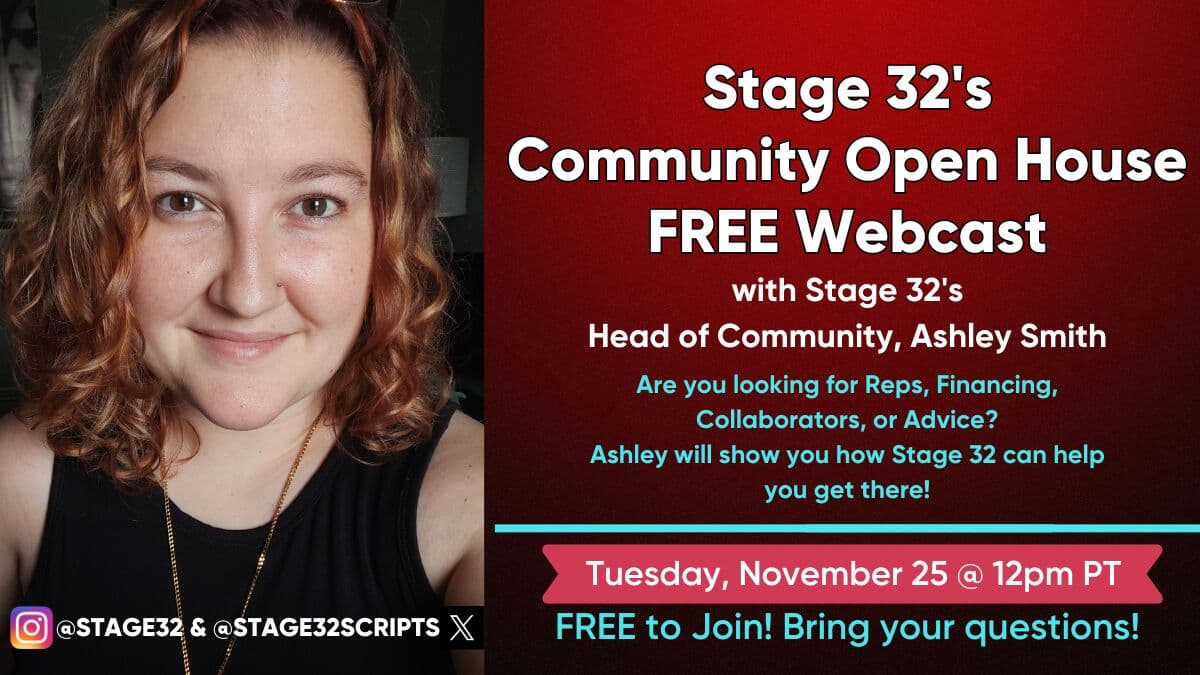Influencers vs. Investors - The Future Of Film Funding

Influencers vs. Investors - The Future Of Film Funding

After publishing my most recent blog, “Why Crowdsource Funding is Essential for Independent Producers”, there was some interesting feedback that pushed back, stating big investors are still the only legitimate way to fund film or other media projects. It was pointed out to me that, “If your goal eventually is a feature film that will be distributed internationally then you are stepping into serious business, and the film should carry the weight of serious business in both its creation and financing.” As someone who just received seed funding for their first feature film and is currently making headway with those big inventors, I’d like to unpack some of the truth and the inaccuracy of that assertion from my personal experience and from the wealth of insights that we've all received in the Stage 32 Financing Lounge.
Let’s Cut To The Chase, Shall We? Audiences Fund Your Film.
Investors front the money on the chance that audiences will consume what you’ve made and make their money back in the process. But investment money is not the ultimate goal - audience money is. So, if you want a well-funded film, have a system to gauge your audience’s response to your prepared material. For Legion M, they have their community vote and give feedback during development. The producers of Sound of Freedom crowdfunded $5 million, clearly demonstrating that a film can be distributed internationally, doing serious business, even when crowdfunding is at the heart of its financing.
How does crowdfunding relate to Influencers, you ask? Why, Influencers are crowd creators! Sure, they are likely also CONTENT creators, perhaps even filmmakers or writers or actors themselves. But in creating their content, they’ve also curated a crowd. A crowd has a better chance of consuming what YOU make if you ally yourself with them and entice them with a familiar face in a key role. But before we dive into the pros and cons of attaching an influencer or pursuing an investor to help fund your film, let’s get SUPER clear about what funding options are available across the board.
PREFACE: General Film Funding Options
Self-Financing-
It’s all on you: work a second job and put the money towards your project; you can also re-route an inheritance or trust to finance your project; OR work your normal job and cut expenses to the point where you can put some major amounts towards the project (and you wonder why independent filmmakers start out by living with family and friends).
***For those of you who are truly entrepreneurial, you’ve probably already thought about using your personal funds to create something at a lower price point than a film or series - say a comic book - then sell that, and use the profits from one project to fund the next project. This is also a version of “self-financing” that simply takes longer and has a higher risk as you may not make enough to fund the next project, or any profit at all. BUT you also don’t have to worry about paying interest, submitting applications, or changing your creative vision to snag that cash.
Pre-Sales-
Much like self-financing, you’re only selling what you already have. There is no interest to be repaid or a studio to report to, but you do have to deliver. For more information on how to seal those Distribution Deals, check out the upcoming 2-part class with Kristin Harris at Vertical Entertainment, “Your Definitive Guide to Distribution Deals”.
Grants-
Opportunities for free money, no need to pay it back, although they will want a thorough submission package to know what you’re making, why you’re making it, who is attached, and where it will play. Grants also tend to support the filmmaker’s vision instead of making demands on that vision. Sometimes there are requirements if those grants are from a public or government source, like a film commission.
Contests-
Same idea as grants, but there are usually rules for what you can submit, and so the contest can skew the creative output by having those requirements. Having limitations on the vision in order to win a contest isn’t all bad. In fact, it can foster creativity, but be sure you choose your contests to support the project, not undercut it.
Loans-
Gap Financing via Banks; technically, investors could be seen as a version of a private lender, especially Class V investors who contribute at the development stage and with smaller amounts ($1,000 - $10,000 each) which is repaid with interest at greenlight (so when your project goes into pre-production, your Class V investors wrap up and are not involved after that).
***Did you notice how Class V Investors sound a bit like your high-rolling Crowdsource Funders? The big difference is High-Rolling Crowdsource Funders receive STUFF instead of INTEREST. STUFF can include credits on your project, which, for some, is far more important than more money.
Crowdsource Funding-
Small Amounts from Lots of People, no expectation for ROI, but high expectation for staying involved and informed. This is where having a track record as an influencer/content creator can help you to raise money.
Investing-
Larger Amounts from Few Sources; Class V has low risk and set ROI, Class A has high risk and higher potential for ROI. This is your classic investment structure with points on the back end. This form of funding also requires lots of time. Not just to build up your pitch for your project, not just to build up your name and reputation, not just to build up your team, but also to sign all the paperwork and ensure you are abiding by the SEC ( ) regulations. This is particularly important if you are receiving funding from entities that are not solely made to fund films. If your potential investor is a hairdresser with a million dollars to throw in the pot, then you’ll have to draw up legal paperwork that typically costs $10,000 minimum. It’s less paperwork when you receive investments from entities whose entire existence is built to fund films, but they also have higher standards - less money, and more time.
Okay, who gets the gold star? Who noticed that INCENTIVES are not on this list?
Good job, gold star! Why was it left off? Because it is not upfront money that will allow you to greenlight a project. Greenlit usually requires all funds to be in the escrow account at the same time before moving into pre-production, but production will not receive those incentives until production is wrapped. This is why so many independent productions will use their tax incentives towards marketing - they don’t have to include it on the initial budget, and the extra money only helps them in the endeavor of getting the word out. Some producers prefer to use it as the initial amount paid back to production so they can ensure an ROI. Either way, that money is not accessible at greenlight. SO, incentives are not a film funding source so much as a film cushion source.
Want to learn more about Feature Film Financing? Be sure to check out Stage 32’s Feature Film Financing Agreements Certification! Not only will you learn more about financing options, but you’ll also leave feeling more confident about how to execute the agreements when faced with different funding options. There is also an Investor Agreements for Films Certification that’s not to be missed! Want to learn it all at once for a Master Certification? Jump on Stage 32’s Key Production Legal Agreements Master Certification which includes both of the certifications above plus five others!
INFLUENCERS - Pros & Cons For Filmmaking Producers
Let’s start by confirming, YES, every producer struggles with the same “chicken or the egg” situation - do I secure talent first and then pursue investors? Or do I secure investors and then pursue talent? The answer? Yes. Helpful? Absolutely not. And here is where the Influencer / Content Creator / Crowdsource Funding option becomes desirable - as an independent producer, you need a NAME that will ensure AUDIENCES will see said independent film. Influencers are typically easier to get a hold of and may have a bigger following than your A-list talent. Plus, they already know how to engage their audience, so you get the added benefit of having a marketing strategy using an Influencer as on-screen talent.
PROS: Data-driven relationship, possibly a mission-driven relationship, has a palpable audience to test things out with and receive more data throughout the process; their audience is more forgiving if there are delays in production; they may also be receptive to tiered funding (meaning funding for development, production, post-production, and/or marketing may be at different times).
CONS: Not all influencers are great for the role, even if they’re great for marketing, so be sure you audition them before you sign anything; the number of followers does not guarantee ticket sales, so be sure to measure crowd engagement, and offer private screenings to their “crowd” before it releases. You have direct access to your audience, which means they will have opinions throughout and will want opportunities to be heard. You will have to account for a certain amount of Community Management to appease and engage them.
INVESTORS - Pros & Cons For Filmmaking Producers
Before there was Legion M or Angel Studios - both of whom have created a dedicated community for their projects’ fans from which they directly solicit opinions about what future projects they’d like to see - investors would look for evidence that a target demographic would purchase the product attempting to be sold. Independent Producers had figured out that one way to quantify an audience demographic was by their response to posts online - Twitter threads, Reddit threads, Facebook groups, LinkedIn Groups, and even Instagram threads specifically for business or influencer accounts. Because investors look at numbers as hard proof and influencers can generate enough data from their audiences to provide that information, producers have begun to leverage influencers in order to secure investors.
PROS: Big money, which can help in securing bigger-named talent, who are more likely to be better qualified to act in a role; no interjections into the creative process; can do research without working with the source of the research.
CONS: They require data from you, so you still have to collect and show projections of success before they agree to give you the funding; contracts usually include deadlines and a timeframe for repayment (if it includes a loan), neither of which are particularly flexible; you don’t get any investment money until you get ALL investment money, so if you ask for $1 million, and find out in post-production you need another $500,000, you cannot go back to your investors.
HYBRID FUNDING - The Future of Film Funding
Not Crowdfunded, COMMUNITY FUNDED
Creating and fostering a community is what the best influencers do. Whether you employ them and tap into their community or you create your own, every Independent Producer should find a way to utilize a well-defined community from which to start funding. While a CROWD looks good in numbers, it only speaks to the quantity of a potential audience. A COMMUNITY is a better gauge of that crowd’s engagement. After all, if you only have 1% of your audience interacting with your posts, then you’re losing the money from the remaining 99%.
Not Social Media, Social Responsibility
Every influencer found their community by identifying what they all have in common. Once identified, they took some amount of responsibility to address that commonality with some sincerity. While the platform that allowed them to connect may be “social media”, the ideology that allowed them to connect is what keeps their community engaged. Identify what you are offering, give your community a taste of it on a regular basis, and see how they show up based on your mission.
After reading Laurie Ashbourne’s recent book, VALUES: Rethinking Hollywood Film Investment for Maximum ROI & Impact, I’ve come to double down on this funding strategy. She articulates it clearly in her introduction, “Every film is the equivalent of a start up business. As such, why should said business be excused from corporate expectations of social responsibility? There is no reason why films should not be utilizing… Impact Investing, which has taken off in every other sector across the globe in the past decade.”
Not R&D, Research Throughout
Angel Studios not only has their community vote on “torches” through development, they also do test screenings until they have undeniably high ratings to ensure that audiences will love the end product. This dedication to audience satisfaction was pivotal in the recent success of The Chosen (2017- ) series and Sound of Freedom (2023) film. Take the time to utilize your community at every stage possible because more information only helps your “calculated risk” of investment.
PICKING UP WHAT I’M PUTTING DOWN?
For those of you who are familiar with the Production Triangle, you’ve likely already picked up what I’m putting down here. You can go with traditional investors, but it will cost you more TIME. You can go with less traditional investors, which could be faster, but it will definitely cost you more MONEY. You can go with a less traditional system altogether, like tapping into the Content Creator Culture, but it may cost you more QUALITY.
As some of my fellow feature producers have stated:
"Look at [crowdfunding] as a tool in your toolbelt, not the end all be all [of fundraising]." - Garrett Adams
"You don't want to put all your eggs in one basket, so you want to explore all avenues. It also depends on the project. Certain films are easier to market than others." - Ben Mehr
So… what mix of Influencer and Investing are you pursuing?
Let's hear your thoughts in the comments below!
Got an idea for a post? Or have you collaborated with Stage 32 members to create a project? We'd love to hear about it. Email Emily at blog@stage32.com and let's get your post published!
Please help support your fellow Stage 32ers by sharing this on social. Check out the social media buttons at the top to share on Instagram @stage32 , Twitter @stage32 , Facebook @stage32 , and LinkedIn @stage-32 .
About the Author

Karen "Kay" Ross
Host/Presenter, Director, Producer, Voice Actor, Screenwriter, Actor, Researcher, Script consultant, Story Analyst
Kay Ross is an actor, producer, writer, and champion for the "inner teenager.” While being a producer on a television show like Netflix’s “Sex Education” would be a dream realized, for now, she kicks ass on shorts, features, and hosts a weekly IGLive to empower creatives called “The Victory Round.”...











